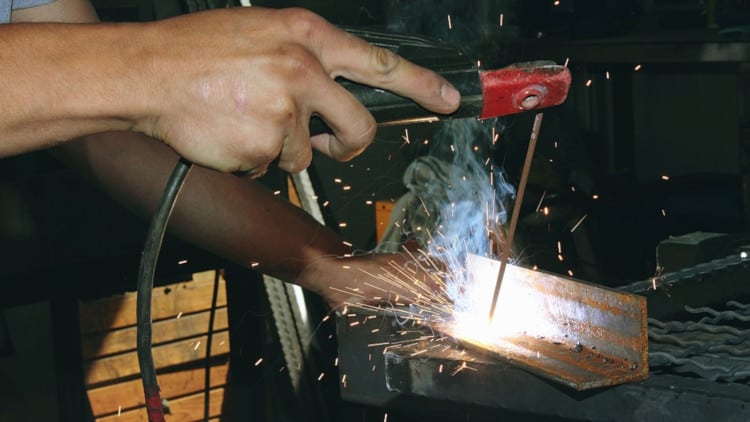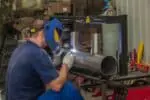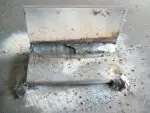Yes, you can most certainly weld cast iron to steel. There are certain things that you need to keep in mind before you get into this whole process of welding them together.
And I will be covering all of them in this article today, so that it is easier and simpler for you to get the job done by avoiding a few obvious mistakes that one might make when attempting to weld the two together.

I will go straight into the points to note when welding cast iron to steel.
If you follow the below points, you will have a successful welding project.
1. You have to be absolutely certain that what you have in hand is cast iron and not some other material that has a high melting point. That will just ruin everything because many a time we might confuse ourselves between different types of iron castings.
They may all appear to be the same to look at but with completely different metallurgy. Even different types of cast iron will act differently, so you want to be sure of what you have in hand before welding it together with steel.
2. If you want to weld cast iron and steel together for repair work or something on those lines, then make it a point to look for damage signs or stress cracks on any of the materials.
Because if there happens to be any sort of damage, you might as well replace the casting before fabricating them together only to replace it at a later stage.
3. Since cast iron has a lower melting temperature compared to steel, your welding machine needs to be pertinently adjusted accordingly.
You also have to pay extra attention to the thinner pieces of the cast iron so as to not ruin it completely by blowing holes incorrectly into them, for the lack of judging the thickness of the walls correctly or for that matter the machine was on high.
4. In the case of a small casting work, you should preheat the casting to prevent it from cracking near the area that needs to be welded. Heating should be done within the scope of 500-1200 degrees Fahrenheit, but not exceeding 1200 degrees.
Even warming the weld area up to 100 degrees will suffice if you aren’t able to preheat the entire chunk. You should sheathe the entire segment to slow down the cooling process in case you preheated it, because if it cools down fast, tiny cracks may start forming on the part. It won’t be the worst idea to apply a sealing blend to get watertight security.
5. Welding should be done 1 inch at a time because it will assist in eradicating cracking. You have the option of stitching the welding components together to later go back and fill the void.
Please remember to focus on the above points before you start welding cast iron and steel together.
The various ways to weld cast iron to steel
You now know what precautionary measures you need to take before the welding process, so now I am going to give you few ways to weld the two components together for whatever reason you may have in mind for wanting to do this.
1. There is something called Decorative Welding, which involves welding fancy iron items onto mild steel. The good thing is for this you do not need to ensure that the connection between the two is highly strong.
You can achieve this by simply using stainless wire because of its high nickel content, with a Flux-Core Arc Welder or Gasless MIG, that will ensure the two glue together. This is the best option if the materials are thin, and you want to get the job done quickly, however, do note that your welds may not be the most durable.
2. For a real welding job you will need something more rugged, and for that, you have your MIG or TIG welding that comes with a nickel-based wire or rod. They also go by the name of Ni-rod. You can always check with your local welding supplier for a better idea of this type of machine and wires.
As mentioned previously, about how easily cast iron can crack when welding, and in order to try and avoid this, is by slowing down its cooling process. There are ways to do this – you can use hot sand to bury the weld into, or covering it with a ceramic fiber blanket will help as well.
3. Another great way to weld cast iron to steel is by using mechanical fasteners, because the former can be easily cut, and drilled.
Otherwise, you can always try brazing, for which you would need an oxyfuel torch and flux-core braze. My suggestion would be to practice a little on materials like copper pipes before going for the iron straightaway.
4. Stick welding is a good technique for welding cast iron to mild steel. Use a slag brush to do some hammering and fastening to make the job easy. For best results, you should work at 95 Amps using a DCEP (Direct Current Electrode Positive).
See also: How to Weld and Keep Steel from Bending?
Can you weld cast iron to steel with a MIG welder?
Yes, you can weld cast iron to steel with a MIG welder, however, most professional welders will not recommend this option because the welded joint won’t be as strong as when done with the MMA technique.
So if you are considering this option, then you can follow the tips I have mentioned below that will be helpful.
1. Specialty nickel wire is the best and the most expensive option in MIG wire, but a good less pricey alternative is stainless steel MIG wire for welding cast iron.
2. Apply the 80% Argon 20% Carbon Dioxide gas method, but the drawback of this will be rusting of the metal. Cast iron is anyway susceptible to rust.
3. The cast can be bonded with a brazing wire, but this can lead to a weak weld. For metals that can presumably encounter loading and impact, this is not the best option.
4. Depending on the kind of job you are performing, you can apply studding to secure the mechanical strength of the welding.
Which welding is best for cast iron?
This is one of the most asked questions for welding cast iron. And the most applied welding technique or method is the MMA (Manual Metal Arc) or SMAW (Shielded Metal Arc Welding) or Stick Welding.
It is the most versatile of all methods, quite flexible, and can resist the cons of the process with its vast number of consumables.
However, the biggest drawback is that a high weld metal weakening is caused by the casting due to its high infiltration arc.
DIY welders prefer this method because of its simplicity and the fact that you can find several arc welders at a justifiable cost for both domestic and commercial objectives and a variety of electrodes can be applied to serve various jobs. You just have to make sure to be using the appropriate welding rod for the work.
Mainly iron and nickel-based electrodes are used for MMA. The former is used for minor rehauling casting, and to match color because it produces weld metal with high carbon martensite.
The more ordinarily used one is the latter one as it gives you a more ductile weld metal, plus it aids in reducing the pre-heating and cracking of the cast iron.
Nearly all types of fundamental adjustments can be fruitfully done by brazing either with a bare bronze rod, flux, and acetylene torch but this will depend on the price, whether it is machineable, and if it is a single or multiple pass weld.
Cast iron welding rod specification
There are different types of rods that can be used for welding cast iron, and choosing the right one is an essential step too.
-
-
- 99% Nickel Rods
-
These types of electrodes yield machineable welds that best work on castings with a phosphorous composition ranging from low to medium.
A supple, and pliable weld deposit is cultivated from such pure nickel rods. They will give you the best results when welding but are the pricier choice.
-
-
- 55% Nickel Rods
-
These types of electrodes also generate machineable welds like the 99% nickel rods but are cheaper comparatively and are mostly used for the rehabilitation of thick sections.
If you want to weld cast iron to steel then these rods are a perfect choice. It generates lesser fusion line cracks than the 99% nickel rods due to a lower co-efficient expansion.
-
-
- Steel Rods
-
These types of electrodes are not machineable like the other two options and create hard welds, the finishing of which need additional grinding. It is the ideal choice for all trivial repairs and fillings and is the cheapest alternative among all three.
Steel rods are best at tolerating castings that are not thoroughly clean prior to the welding process and give a matching color as well.
Wrapping up
These are methods that I have tried and tested myself, so I can vouch for them. However, I am always learning more as I go and will keep adding more information with time. I hope this information helps you to begin with for your first welding cast iron to steel project.
It is not the toughest thing to do and it is not rocket science. As long as you follow the accurate methods and procedures, you are good to go.
The basic rule to always remember is that you need to try and avoid the cast iron from cracking because once that starts happening, it becomes a challenge to retrieve from it.






